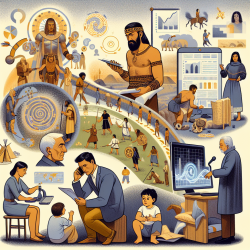Empowering Practitioners: Insights from Ancient Scythian Lifeways
In the realm of speech-language pathology, data-driven decisions are pivotal in shaping effective therapeutic strategies. A fascinating study, "Re-evaluating Scythian lifeways: Isotopic analysis of diet and mobility in Iron Age Ukraine," offers valuable insights that can inspire practitioners to enhance their research skills and therapeutic approaches.
Understanding the Study
The study delves into the lives of Scythian populations, traditionally perceived as nomadic warriors. However, isotopic analysis of human remains from Iron Age sites in Ukraine challenges this narrative, revealing a more complex picture of Scythian lifeways. The research highlights the diversity in mobility and diet among these populations, suggesting a blend of agro-pastoralism and localized mobility rather than a purely nomadic existence.
Key Findings and Implications
- Mobility Patterns: The study found generally low levels of human mobility in urban locales, with some evidence of long-distance travel. This suggests a stable community structure with occasional inter-regional connections.
- Dietary Insights: The isotopic data indicated a reliance on millet agriculture, with varied dietary practices across different regions. This reflects a complex subsistence strategy that integrated agriculture with pastoralism.
Applying Insights to Speech-Language Pathology
Practitioners can draw parallels between the study's findings and their therapeutic practices. Just as the Scythians adapted their lifeways to their environment, therapists can tailor interventions to the unique needs of each child. This requires a nuanced understanding of the child's background, much like the isotopic analysis provided insights into Scythian diets and mobility.
Furthermore, the study underscores the importance of comprehensive data collection and analysis. Practitioners are encouraged to adopt a multi-faceted approach in assessing and addressing communication disorders, considering factors such as cultural background, environmental influences, and individual preferences.
Encouraging Further Research
This research invites practitioners to engage in further exploration of how historical insights can inform modern therapeutic practices. By integrating interdisciplinary research into their work, therapists can develop more effective and culturally responsive interventions.
To read the original research paper, please follow this link: Re-evaluating Scythian lifeways: Isotopic analysis of diet and mobility in Iron Age Ukraine.










